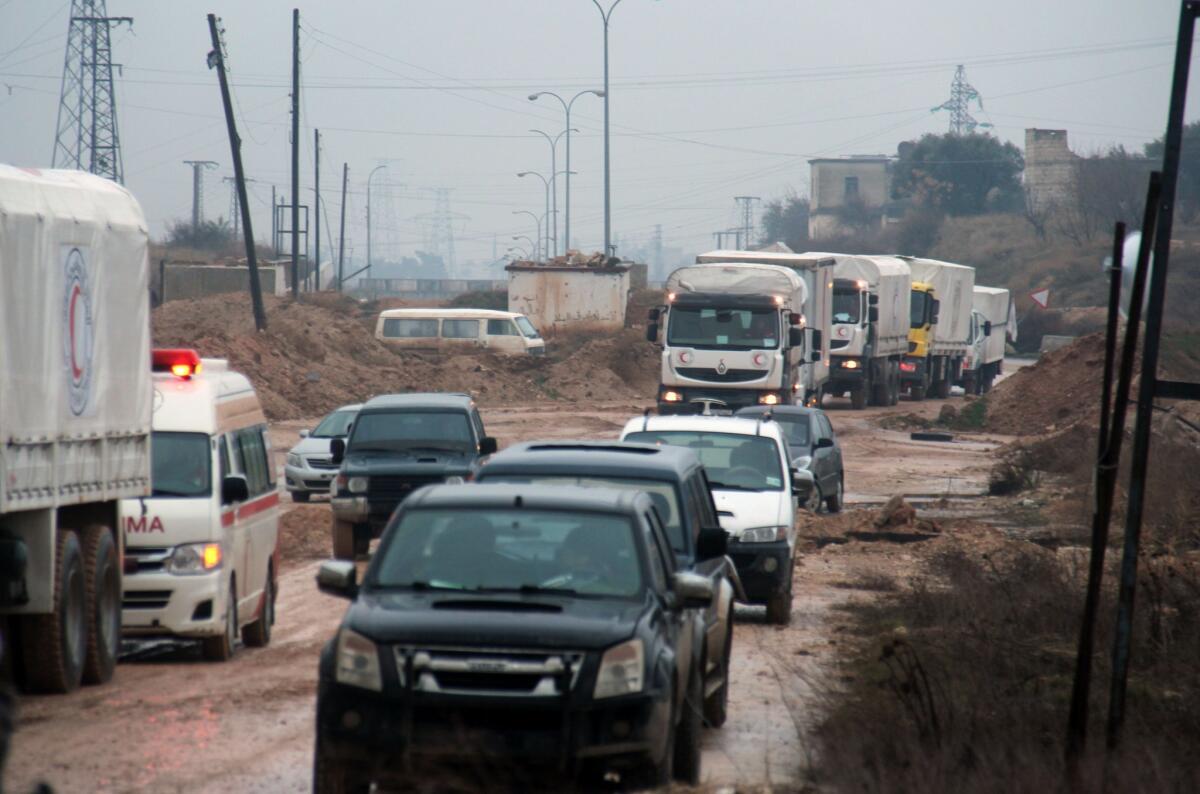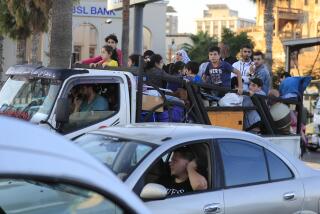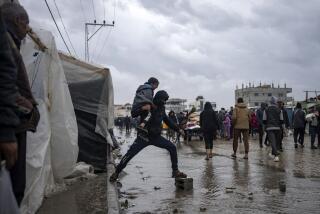Food and other supplies reach besieged Syrian towns, aid officials say

Aid vehicles head to the government-controlled Syrian towns of Fuaa and Kefraya on Monday.
Reporting from Beirut — Trucks carrying food and other desperately needed supplies began entering a trio of besieged Syrian towns on Monday, in a bid to avert what aid officials had warned was a looming humanitarian disaster.
The aid shipments, which were organized by the International Committee of the Red Cross, the Syrian Red Crescent and the United Nations, arrived late Monday amid reports of starvation in Madaya, an opposition-held town northwest of Damascus, the capital. Madaya has been besieged by pro-government forces for months.
As many as 42,000 inhabitants of Madaya have been trapped, with limited access to food and medicine, according to humanitarian groups, leading to elevated levels of malnutrition. Reports from local aid agencies have indicated that at least 50 people have died in recent months of starvation and a lack of medical care in Madaya, according to a statement Monday from eight international humanitarian organizations.
The assistance to Madaya marked the culmination of complex negotiations that also allowed aid convoys on Monday to enter Fuaa and Kefraya, pro-government towns in Idlib province about 180 miles north of Damascus.
The two northern towns, home to more than 20,000 people, predominantly Shiite Muslims, have been cut off for more than two years by armed opposition groups, including Al Nusra Front, the official Al Qaeda affiliate in Syria. Shiites are viewed as apostates by Al Qaeda and other Sunni Islamist factions that dominate the armed opposition in Syria.
Four trucks bearing aid had cleared the last government checkpoint outside Madaya and were in the town Monday, Pawel Krzysiek, spokesman for the Syrian delegation of the International Committee of the Red Cross, said in a phone interview from the outskirts of Madaya. An additional 40 trucks were slated to go in, the spokesman said, adding that offloading operations of 21 trucks had already begun in Fuaa and Kefraya.
“It’s a matter of coordination and synchronization among the different groups,” said Krzysiek, stressing the complexity of an operation that crosses government and rebel lines and involves negotiations with various warring factions.
Apart from food and water, the trucks are delivering infant formula, blankets, medicine and surgical equipment to the towns, which are also dealing with winter weather, officials said.
The supplies are sufficient to feed 60,000 people for one month, the World Food Program said -- 40,000 in Madaya and 20,000 in Fuaa and Kefraya.
In a telephone interview, a member of the pro-opposition local council in Madaya confirmed the entry of the aid convoy.
“I’m now inside the Jeep accompanying the first four trucks,” said the opposition official, who goes by a nickname, Ghadeer Zabadani, for security reasons. “People are so happy. It’s as if it’s the last day of Ramadan [the Islamic month of fasting], and now it’s the time for Eid al-Fitr,” the festival marking the end of Ramadan.
The trucks, he said, would be offloaded in warehouses in the area and the goods would be distributed by the local council.
Madaya, a former resort town famous for its spring water and vibrant market, has been the target of an offensive by the Syrian army and its ally, the Lebanese Shiite group Hezbollah, aimed at driving the rebels from Damascus.
In the last week, however, Madaya has also become a focal point of the fierce information war that has accompanied the armed conflict in Syria. Using social media, pro-opposition activists have circulated images of gaunt individuals identified as starving Madaya residents, said to be subsisting on water, grass and even the meat of slaughtered cats.
There was no independent confirmation of the authenticity of the images, which received global media attention. Independent journalists and monitors generally do not have access to Madaya or other besieged areas.
Still, the images from Madaya led to widespread condemnation of Hezbollah, which was accused of enforcing the siege on Madaya in support of the government of Syrian President Bashar Assad.
Hezbollah and its supporters, however, blamed the rebels for Madaya’s plight, contending that opposition gunmen had in effect held the town hostage, barring the departure of residents and hoarding supplies from October, when the last aid shipment entered Madaya.
Hezbollah and other pro-government groups and media outlets also denounced some of the images of supposedly starving residents of Madaya as fabrications. Lebanese press reported that one photo purportedly showing an emaciated girl in Madaya was actually a doctored Facebook image of a 7-year-old girl living in southern Lebanon.
“The terrorists are stealing the humanitarian assistance,” Bashar Jaafari, Syria’s ambassador to the United Nations, told reporters in New York, dismissing opposition allegations that government forces inflicted starvation on communities. “They are keeping this assistance in their warehouses and then use it as leverage for political and financial gain.”
The Syrian conflict, now in its fifth year, has seen widespread use of siege tactics by both government and opposition forces. Troops and militiamen from both sides have surrounded, sealed off and bombarded towns, villages and neighborhoods in a bid to force fighters in those areas to capitulate.
Across Syria, according to international aid groups, more than a dozen areas remain in crisis with inhabitants barred from leaving and aid workers blocked from delivering food, medicine, fuel and other essential supplies. Prices for foodstuffs in those areas inevitably soar, creating a black market for staples.
More than 4.5 million people in Syria now live in besieged or “hard-to-reach” areas, which face periodic shortages of food and other vital supplies, according to international aid agencies.
On Monday, eight international aid agencies called for all parties in the Syrian conflict to end the sieges of civilian areas and ensure permanent access to humanitarian supplies.
Bulos is a special correspondent.
Twitter: @mcdneville
More to Read
Sign up for Essential California
The most important California stories and recommendations in your inbox every morning.
You may occasionally receive promotional content from the Los Angeles Times.










